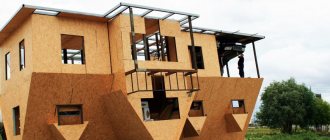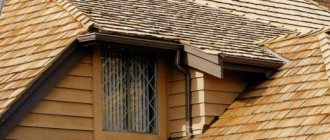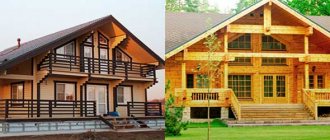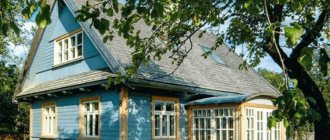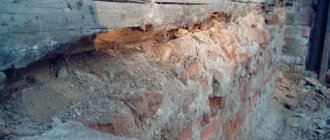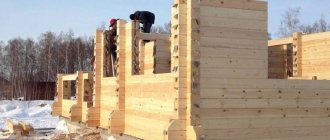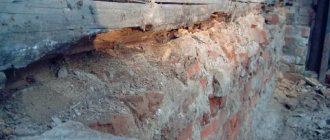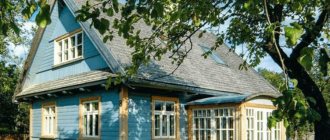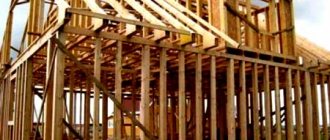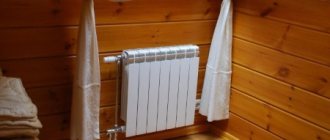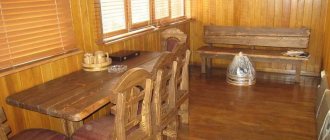The service life of a wooden house is a relative parameter and not always clear. Durability depends on compliance with the rules of operation: a cottage can stand for more than 100 years and be well preserved, or it can turn into a wreck in 30-50 years.
Such uncertainty confuses buyers of ready-made cottages. Is 20 years a long time for a residential building? How long will a house last if it was built 50 years ago? In the article we will tell you in more detail about the standard service life of a wooden house, what determines durability and when it is time to demolish the cottage.
The oldest surviving wooden house was built in the 11th century
To begin with, here is an example of a long-lived house. The building is located on the island of Streymoy (Denmark). The approximate date of construction is the 11th century.
The oldest wooden house, photo from the website przepisyzpodrozy.pl The building was built from wood washed ashore by a storm. There are no large trees on the island, so wooden housing is valued: the construction was looked after and monitored. As a result, the building stood for 900 years and is still in use today. It's not quite the same with other wooden buildings.
Waterproofing the foundation
In order for the foundation to be strong, not warped, and shrinkage to be correct and uniform, it is necessary to carry out work to protect the foundation from the harmful effects of moisture.
There are two types of waterproofing:
- anti-filtration - not used very often, mainly in cases where the aggressiveness of moisture is increased;
- anti-corrosion is a popular solution; waterproofing can be impregnated, backfilled, painted, pasted, or plastered.
The main goal of waterproofing work is to protect the foundation in two planes, horizontally and vertically.
The service life of a house made of timber according to GOST is 50 years
The numbers are not taken out of thin air: at least 50 years is the recommended service life of buildings under normal conditions according to GOST 27751-2014. The standards specify definitions of the general and design service life, requirements, loads, load-bearing capacity, and other parameters. Important term:
Normal operation: use of the facility in accordance with the conditions of building codes, including maintenance, major repairs, reconstruction.
Normal use is used to determine service life:
- calculated (before major repairs or reconstruction);
- general (before demolition of the building).
Regular maintenance is not a whim of builders, but a mandatory condition for the operation of a building. When determining the schedule and composition of maintenance, the influence of the environment, the properties of materials, means of protection against negative influences, and the rate of degradation of materials and protective coatings are taken into account.
Factors Affecting Durability
Properly selected materials and strict adherence to technological requirements during construction will make the home as warm, strong and durable as possible. A wooden cottage may well turn into a family nest, in which the grandchildren and great-grandchildren of the first owners will happily gather.
The lifespan of a wooden house depends on several factors:
- The material chosen for construction. Coniferous wood is characterized by the greatest durability: due to the high resin content in its composition, it more effectively resists biological threats.
- Correct calculation of the house’s ventilation system, waterproofing, and plumbing installation. Equipping a home with communications must be carried out in strict compliance with current regulations.
- Mandatory waterproofing of the foundation. It is the lower crowns of the log house that are the first to suffer from moisture, so care must be taken to protect them from contact with moisture.
- High quality finish. Properly selected materials must be used for it, and the manufacturer’s recommendations must be strictly followed when applying them.
These are only the basic factors on which the service life of a timber house will depend. Proper construction and subsequent maintenance can make a wooden house more durable than even a brick cottage.
How to determine the age of a log house
Find documents. If the cottage was built and formally registered, then you can easily obtain documentary evidence.
Ask your neighbors. Old-timers usually remember when cottages appear on neighboring plots. Moreover, you can find out from your neighbors who built it, what it was used for, how long the construction lasted, how the house was used, and other useful information. It’s worth talking to your neighbors, even if there are no questions about the age of the cottage.
Conduct radiocarbon dating. Testing a sample in a laboratory determines exactly when the tree was cut down. Radiocarbon dating is usually used in archaeology, but the technology is also suitable for determining the age of a wooden house. The service can be ordered in a specialized laboratory. The cost, including purification and isolation of cellulose for dating, is 7-10 thousand rubles.
Seek help from an expert. An experienced specialist will tell you offhand when the house was built with an accuracy of 3-5 years. But something else is more important - an engineer can conduct a professional assessment of the building in accordance with GOST 31937-2011. You receive a full report:
- diagrams, descriptions, photos of defective areas;
- results of checking the deformations of structural elements (deflections, rolls, distortions, faults, etc.)
- list of emergency areas;
- updated design diagram;
- assessment of technical condition;
- recommendations for repair or reconstruction.
With such a report, you can make an informed purchasing decision, calculate the cost of repairs in advance, and demand a discount. During a professional examination, the construction date is taken into account only formally. The actual performance of a structure is much more important than its age.
How to ensure the longevity of log cabins?
If you need to increase the durability of a structure, you can use the most effective methods:
- Choosing a tree species. The best wood is pine, pine needles, spruce, cedar and larch. When harvesting it or purchasing it from construction companies, you need to pay attention to the quality of the wood itself and the quality of processing of the material. Larch lasts much longer than pine. It is best to purchase wood harvested in winter.
- Reliability of the foundation and type of soil. A properly selected foundation (in terms of depth and material) and its waterproofing will reduce the influence of groundwater and soil characteristics on log walls.
Log protection. Depending on climatic conditions, it is necessary to carry out high-quality and regular treatment of wood from moisture, fungus, rot, mold, rodents, and pests.
For this purpose, special impregnations, paints, fire retardants or antiseptics are used.Thus, a white fungus can infect and cause irreparable damage to wood 4 cm thick in just a month.
- Protection from fire and fires. Treatment with fire-retardant compounds and impregnations will protect the house from fire or slow down the combustion process. The product can be applied with brushes or using a spray bottle.
- Proper arrangement of wall insulation and ventilation systems. Excess humidity, the appearance of condensation on the walls, the presence of drafts and cold bridges - all this reduces the durability of the log. Therefore, creating an optimal temperature regime in the room, protecting the house from freezing and having a ventilation system will help extend the service life of the material.
- Timely, proper care. As long as there are people living in the house who take care of the building and keep it in a safe condition, the house will be in use for a very long time. Therefore, regular inspection of the building, repair and elimination of defects is the key to the durability of the entire structure.
What determines the durability of a wooden house
General rules for maintenance of single-family houses, design options, requirements for planning, energy saving, fire safety are specified in SP 55.13330.2016. In practice, to increase service life, four conditions must be met:
- Choose the right material. In wooden construction, logs, solid beams, and laminated veneer lumber are used. Each material has its own characteristics of use. Read more about the choice in the article “The best material for building a house.”
- Maintain temperature conditions. Ideal conditions for a cottage are permanent residence of the owners, when the optimal temperature is established without changes. If the building is used sporadically, if it is suddenly warmed up in the cold, cracks appear on the wood, the frozen walls thaw and freeze again, and gradually collapse.
- Perform protective treatment in a timely manner. Wooden walls need to be impregnated with antiseptic and painted.
- Carry out regular maintenance. The design must include anti-shrink devices that regulate for uniform, predictable shrinkage.
Wood
The raw materials used are the primary factor! Compare pine beams with a cross-section of 150 x 150 mm with alder logs. Even within the coniferous group there is a difference: a house made of Siberian pine will last 10 years longer than a house made of Kuban pine.
It also matters which part of the barrel you use. The closer to the crown, the more branches and, accordingly, the shorter the service life of the lumber. The middle of the trunk is more resistant, and the middle part of the pine has the highest quality - it has no knots at all.
When is it time to rebuild or demolish a building?
GOST 27751-2014 provides a list of limit states that are taken into account when assessing maintainability and feasibility of further use:
- Destructions, loss of structural stability, excessive deformations, increase in crack size, and other signs of loss of bearing capacity. If measures are not taken, this condition leads to an emergency situation.
- Achieving maximum deflections, vibration levels of structural elements, exceeding the maximum crack opening, corrosion damage and other phenomena that disrupt normal operation. The condition is emergency, reduces the service life. You can't live in such a house.
- Special cases (explosions, seismic activity, vehicle damage) in which a building is partially or completely destroyed.
Please note that service life is not taken into account when determining condition. The date of construction affects the schedule of scheduled inspections and major repairs, but otherwise the age of a timber house is unimportant. If high-quality material was used for construction, construction technology and operating rules were followed - the service life of the house is unlimited.
Reasons for reducing the service life
The service life of log houses can be reduced even with timely maintenance.
Such factors include:
- Climatic conditions. In regions with high humidity and sudden temperature changes, a timber house will last less than one built in the northern part of the country.
- Type of tree. Houses made from laminated veneer lumber are considered the strongest. Buildings made from ordinary timber will last less.
- Violation of construction technology. If the object was built with violations or from low-quality materials, then its useful life may be halved.
- Emergency situations. These include fires, earthquakes, floods and so on. In this case, a person will not be able to do anything.
Sometimes it is cheaper to build a new house from timber than to restore an old one
If the condition of the old building is close to emergency and major repairs are needed for normal operation, then it makes sense to calculate the cost in advance and compare it with the costs of building a new cottage.
In GOOD WOOD you can build a house with a 50-year guarantee, and sign a maintenance contract so that when the warranty period ends, the cottage remains just as strong and reliable.
Individual and serial projects can be viewed on the page “Houses made of laminated veneer lumber”. If you need advice based on the location, the GOOD WOOD architect goes to the site to assess the scale of the work and determine the parameters of the future cottage. House according to an individual project
Thank you for reading this article to the end.
has been offering services for the construction of stone and wooden houses for 10 years.
Our customers include the construction of individual private houses and cottage communities that maintain a single architectural style from economy to premium class.
Reducing construction time, reducing costs and improving the quality of construction work are the basic principles of our company.
We are ready to offer:
- standard cottage designs;
- individual design of wooden houses;
- construction of cottages and turnkey houses;
- finishing works and interior design;
- carrying out repair work;
- improvement of the territory.
Reasons why durability decreases
The durability of cottages may be reduced if:
- No one lives in the room for a long time. Without heating, the building will quickly lose its performance indicators and begin to rot;
- the logs were improperly prepared and processed. The material must be dried in order to remove excess moisture from the wood. In the future, this will help to avoid problems during the construction of walls, and the building itself will not shrink;
- lack of antiseptic and fire protection treatment. In order for the wood to be protected, it must be re-lubricated with special impregnations every 6-7 years. It is also recommended to sand the logs approximately once every 6-7 years, which will provide additional protection and aesthetic appearance, since the old layer will be removed;
- use of rounded logs. Removing bark or rounding can reduce the service life of the material. Therefore, it is better to use simple logs.
Wooden walls and frames
We have decided on one major part of the house. There are still walls left - they also can’t be rebuilt without unnecessary hassle, although if there are problems, but in general the frame “holds”, then you can practice spot repairs. The walls of a hand-assembled log house from debarked logs, which are then sanded, will last up to 75 years; if we are talking about planed (and also sanded) logs, then their service life is 70 years. A log house built from similar planed logs, but not sanded will serve faithfully (remember - in theory) 60 years, and a log house made of rounded logs or timber - 40-55 years.
However, here it is necessary to take into account the peculiarity of wood as a building material - the durability of the building material depends on how much interference occurred in the original structure of the wood during its preparation. The fewer layers of logs are removed, the longer the house built from it will last. Within reasonable limits, of course, because a log house made from the trunks of a three-hundred-year-old sequoia tree, to put it mildly, is hardly suitable in size for the average inhabitant of the Earth. This will be the kind of house for Wun-Wun.
The log house contains not only capital parts, but also replaceable ones. Somewhere with ease, somewhere with difficulty, but they also have their own service life. For example, wooden floors will “live” up to fifty years without much damage, plank floors - about thirty years, a rafter system - also about fifty years, insulation, vapor barrier and water protection - 20-30 years. On average, it turns out that a wooden house will not require close attention (it will still have to be given some attention) for an average of thirty years.
Of the roofing materials, the most durable is natural tile. Experts give her seventy to eighty years of service. Metal tiles will last less - up to twenty to twenty-five years; the service life of soft tiles is approximately the same.
